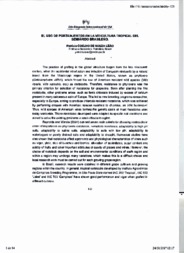El uso de portainjertos en la viticultura tropical de Semiárido brasileno.
El uso de portainjertos en la viticultura tropical de Semiárido brasileno.
Author(s): LEAO, P. C. de S.
Summary: The practice of grafting in the global viticulture began from the late nineteenth century, when the accidental introduction and infection of European vineyards bya natural insect from the Mississippi region in the United States. knownas phylloxera (Daktulosphaira vitifolil), which forced the use of American resistant wild species (Vitis ripens, vitis rupestris, etc.) as rootstocks. Therefore, resistance to phylloxera was the primary criterion for selection of rootstocks for grapevine. Soon after planting the first rootstocks, other problems arose, such as ferric chlorosis induced by excess of calcium present in many calcareous soils of Europe. This led to new breeding programs researches, especially in Europe. aiming to produce chlorosis resistant rootstocks, which was achieved by performing crosses with American species resistant to chlorosis, as Vitis berlandieri. Thus, wild species of American vines formed the genetic basis of most rootstocks used today worldwide. Those rootstocks developed were adapted to specific soil conditions and aimed to solve the existing problems in each viticulture region. Reynolds and Wardle (2001) outlined seven rnain criteria for choosing rootstocks in order of ímportance as phylloxera resistance, nematode resistance, adaptability to high pH soils, adaptability to saline soils, adaptability to soils with low pH, adaptability to waterlogged or poorly drained soils and adaptability to drought. Numerous studies have also shown that rootstocks affect agronomic and physiological characteristics of vines such as vigor, yield, size of bunches and berries, allocationof assimilates, sugar content and acidity of fruits and other important attributes of quality of grapes and wines. However, lhe choice of rootstock depends on the soil and environmental conditions of each region and within a region may undergo many varíations, which makes this is a difficult choice and local research work must be carried out for each growing grape region. In Brazil, research results were obtained in different grape cultivars and growing regions within the country. In general, tropical rootstocks developed by Instituto Agronômico de Campinas Breeding Programme, in São Paulo State named IAC 313 'Tropical', IAC 572 'Jales' and IAC 766 'Campinas' have shown good performance and vigor when grafted in different cultivars. In São Francisco Valley, nematode tolerant rootstocks and moderate vigor such as 'Harmony', 'S04' and 'Paulsen 1103' resulted in better balance between vegetative and reproductive growth and bunches with higher weight, better coloring and general appearance for 'Crimson Seedless', 'Sugraone' and 'Thompson Seedless' table grapes (Leão; Borges, 2011; Leão et aI.; 2011; Leão et ai., 2010). New studies have been performed to evaluate rootstocks for new table grape cultivars BRS Vitoria, BRS lsls and BRS Nubia recently released by Embrapa. In conclusion, the rootstocks use ín tropical viticulture has shown a great importance as a way to prevent soil diseases and pests and to control abiotic stresses, although the responses are specífic for each grape cultivar and environment. Introducción
Publication year: 2015
Types of publication: Paper in annals and proceedings
Unit: Embrapa Semi-arid Region
Keywords: Cultivo, Grapes, Porta Enxerto, Semiárido, Uva, Viticultura, Vitis Vinifera
Observation
Some of Embrapa's publications are published as ePub files. To read them, use or download one of the following free software options to your computer or mobile device. Android: Google Play Books; IOS: iBooks; Windows and Linux: Calibre.
Access other publications
Access the Agricultural Research Database (BDPA) to consult Embrapa's full library collection and records.
Visit Embrapa Bookstore to purchase books and other publications sold by Embrapa.

